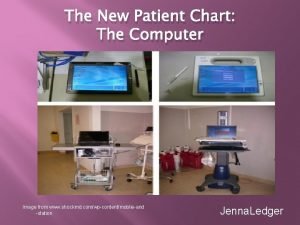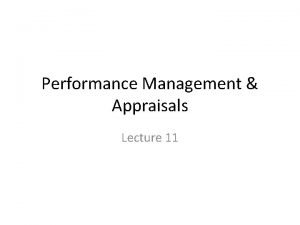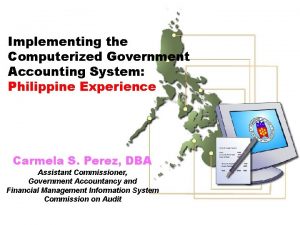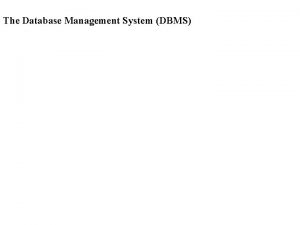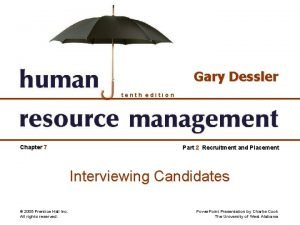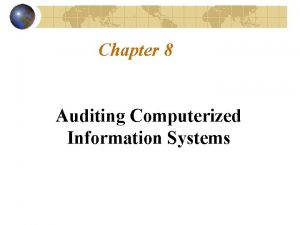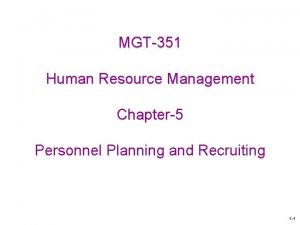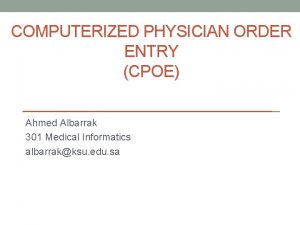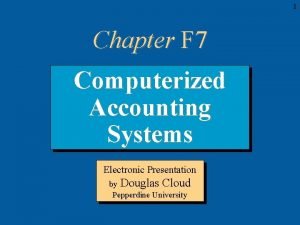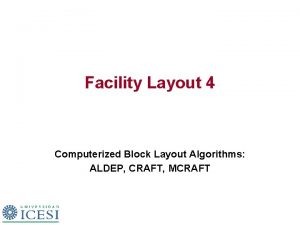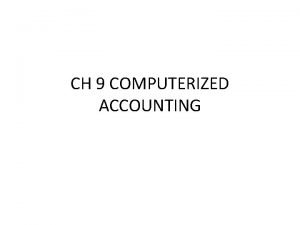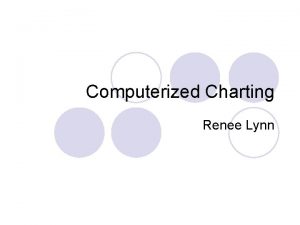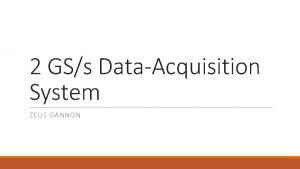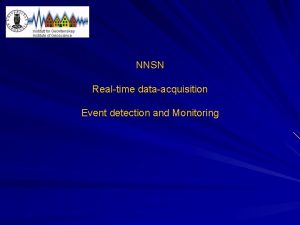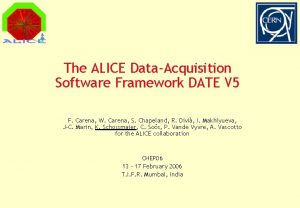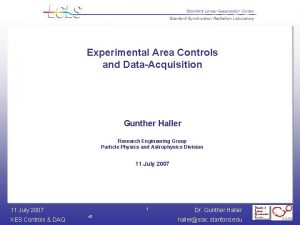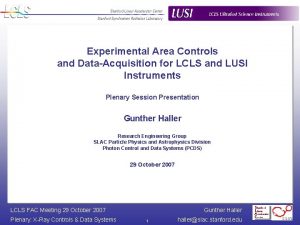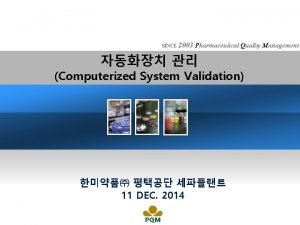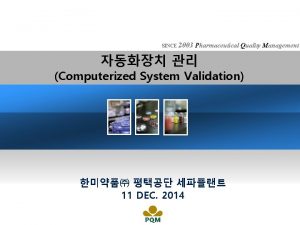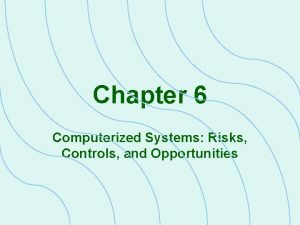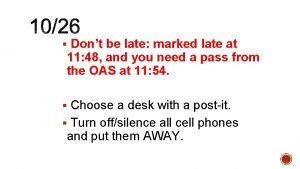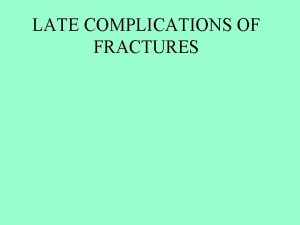CHAPTER 4 Computerized DataAcquisition Systems Since the late























- Slides: 23

CHAPTER 4 Computerized Data-Acquisition Systems Since the late 1950 s, computers have been used to monitor, and in many cases to control, the performance of large process plants such as refineries and chemical plants and to acquire data in major testing programs such as the space program. These systems were extremely expensive and required highly skilled personnel to set them up. In the late 1960 s, lower-cost computer data-acquisition systems became available for smaller tests, but since they were still difficult to set up and program, their use was limited. In the late 1970 s, the simple and reliable Apple II personal computer led to inexpensive and simple data-acquisition systems that could readily be used for small experiments. Personal computer systems (mostly using the Windows operating system) are now so capable that they can be used for a significant fraction of all engineering testing.

FIGURE 4. 1 Computerized data-acquisition system.

Computer Systems for Data Acquisition The computer systems most commonly used for data acquisition in experiments are personal computers using the Windows operating system. Sampling rates of over 10 million samples per second are possible, and more than 3000 separate sensors can be sampled (although not in the same system at the same time). Several major companies supply software and hardware to make a personal computer into a data-acquisition system, and some of the hardware is available in low-cost generic form. Figure 4. 2 shows a board designed to plug into the interior bus of a personal computer and a For monitoring and controlling many production systems, specialized embedded computers are used. Probably the most common embedded computers are those used for fuel control in modern automobiles. However, embedded computer systems are used in a wide variety of devices from medical imaging equipment to assembly-line robots.

Figure 4. 2 Data-acquisition board with eight analog input channels and two analog output channels also showing an analog signal connection box. Manufactured by National Instruments.

Components of Computer Systems Although some computers used in data acquisition are highly specialized (the engine control computer in an automobile, for example), the computers normally used are quite standard and have the following components: • • Central processing unit (CPU) Program (software) Random access memory (RAM) Mass storage systems Display User input device (keyboard, mouse, etc. ) Printers and plotters

Digital input-output (ports or expansion bus) FIGURE 4. 3 Typical computer system.

Tne central processing unit (CPU) controls all aspects of computer system operation and performs all of the arithmetic operations (multiplication, addition, etc. ). The CPU operations follow instructions contained in the user-provided program. The CPU also follows instructions from the computer operating system programs and from built in programs.

Representing Numbers in Computer Systems While numbers used in the everyday world are normally represented in base 10 (decimal), it is far more practical in computers to represent numbers in base 2 (binary). Information in computers is stored in bi stable devices called flip-flops, which can have two possible states. One state is defined as "on" and is assigned a numerical value of 1, and the other state is defined as "off" and is assigned a numerical value of 0. A series of flip-flops are required to represent a number. For example, the binary number 0101, , which corresponds to the decimal number 5, can be represented in a computer Using four flip-flops. Each of these flip-flops represents a "bit" of the number. The left most "1" in the binary number 1001 is the most significant bit (MSB). The rightmost "l" is the least significant bit (LSB). It is common in computers to break long binary numbers up into segments of 8 bits, which are known as bytes.

= 9(101) + 2(100) Find the 8 -bit binary number with the same value as that of the decimal number 92. Solution: This problem can be solved by a series of divisions by 2: is zero for positive binary numbers

• These same 4 bits can alternatively be used to represent numbers from -8 to +7. The positive numbers from 0 to 7 are represented by the three least significant bits, ranging from 0000 to 0111. The negative numbers from -8 to -1 are represented by the binary numbers 1000 to 1111, respectively. • For positive numbers, the most significant bit is always 0, while it is always 1 for negative numbers. To convert a negative decimal integer to 2's-complement binary the following procedure can be followed: Example 4. 3 Convert the decimal integer -92 to an 8 -bit 2's-complement binary number. +92 = 01011100 , invert all the bits, to obtain 10100011 1 then add 1 to obtain the final result, 10100100


Transistors amplify current, for example they can be used to amplify the small output current from a logic IC so that it can operate a lamp, relay or other high current device. In many circuits a resistor is used to convert the changing current to a changing voltage, so the transistor is being used to amplify voltage. A transistor may be used as a switch (either fully on with maximum current, or fully off with no current) and as an amplifier (always partly on). Types of transistor: Watch @ http: //www. youtube. com/watch? v=Za. BLicies. OU http: //www. youtube. com/watch? v=e 0 o. Ux. G 0 e. E 9 s&feature=related http: //www. youtube. com/watch? v=CLLc. RRBph 90&feature=related http: //www. youtube. com/watch? v=GQmt. ITMdas&feature=related These logic circuits can be built very compact on a silicon chip with 1, 000 transistors per square centimeter. We can turn them on and off very rapidly by switching every 0. 00001 seconds. Such logic chips are at the heart of your personal computer and many other gadgets you use today. Vacuum tubes were made containing several three terminal devices called triodes.


• http: //www. google. com/imgres? q=pn+junction&hl=en&sa=X&biw=1024&bih=653&tb m=isch&prmd=imvnsb&tbnid=3 Cdvby 5 O 9 KVoo. M: &imgrefurl=http: //sunnywinenergy. c om/en/About. Sun_02_en. htm&docid=RPDYx. AQeqk. Iza. M&w=465&h=316&ei=AMd 2 Tu. K SB_TYi. AKxt 9 XLBw&zoom=1&iact=rc&dur=503&page=10&tbnh=113&tbnw=166&start= 131&ndsp=13&ved=1 t: 429, r: 8, s: 131&tx=79&ty=52

A p–n junction is formed at the boundary between a P-type and Ntype semiconductorcreated in a single crystal of semiconductor by doping, for example by ion implantation, diffusion of dopants, or by epitaxy (growing a layer of crystal doped with one type of dopant on top of a layer of crystal doped with another type of dopant). If two separate pieces of material were used, this would introduce a grain boundary between the semiconductors which severely inhibits utility by scattering the electrons and holes. [citation needed]. P–N junctions are elementary "building blocks" of many semiconductor electronic devices such as diodes, transistors, solar cells, LEDs, andintegrated circuits; they are the active sites where the electronic action of the device takes place. For example, a common type of transistor, the bipolar junction transistor, consists of two p–n junctions in series, in the form n–p–n or p–n–p.

• 1946: ENIAC completed • Electronic Numerical Integrator and Computer • 18, 000 vacuum tubes. • Occupied a 30 by 50 foot room • Programming by plugging wires into a patch panel. Very difficult to do, because this style programming requires intimate knowledge of the computer.


Four generations of computers 1. Vacuum tube (1939) 2. Transistor (invented in 1947, used in IBM 7090 in 1958) 3. Integrated circuit or chip (invented in 1959, used in IBM 360 in 1964) 1. A small wafer of silicon that has been photographically imprinted to contain a large number of transistors together. 4. Large-scale integration: microprocessor (1975) 1. Entire processing unit on a single chip of silicon Transistors Old CPU's

Basics of Analog-to-Digital Converters • To explain the function of the A"/D converter it is necessary to describe two distinct methods by which electronic systems process numerical information: analog and digital. • Many everyday electronic devices, such as television sets and audio amplifiers, were basically analog devices (although they may have some digital components). • Modern computers, on the other hand, are digital devices. If we are trying to represent a value of 5 V in an analog device, we could, for example, charge a capacitor to 5 V. In a digitaldevice, 5 V will be represented by a digital code (a digital binary number such 0101), which is stored on bistable flipflops.

The two-light-bulb device is a 2 -bit A/D converter. In general, the output of an analog-to-digital converter has 2 N possible values,

A unipolar converter can only respond to analog inputs with the same sign. Examples of the input range are 0 to 5 V or 0 to -10 V. Bipolar converters can convert both positive and negative analog inputs, with +5 V or +10 V being typical input ranges. Figure 4. 6.


 Conclusion of accounting software
Conclusion of accounting software Computerized patient chart
Computerized patient chart Checklist method
Checklist method Government accounting system in the philippines
Government accounting system in the philippines What is corelap
What is corelap When a financial gain accompanies a forgery
When a financial gain accompanies a forgery Enclosure notation example
Enclosure notation example Terms review 5-3 accounting
Terms review 5-3 accounting Computerized layout techniques
Computerized layout techniques Ecommerce accounting procedures
Ecommerce accounting procedures Computerized database definition
Computerized database definition Assetds
Assetds Conducting computerized interviews
Conducting computerized interviews Craft layout example
Craft layout example Types of appraisal interview
Types of appraisal interview Parallel simulation audit
Parallel simulation audit Computerized forecast in hrm
Computerized forecast in hrm Forecasting the supply of inside candidates
Forecasting the supply of inside candidates Disadvantages of cpoe
Disadvantages of cpoe Trims and accessories store department in garment industry
Trims and accessories store department in garment industry Computerized and web-based performance appraisal
Computerized and web-based performance appraisal A computerized account identifies
A computerized account identifies Advantages and disadvantages of aldep
Advantages and disadvantages of aldep Lesson 4 the late middle ages
Lesson 4 the late middle ages

